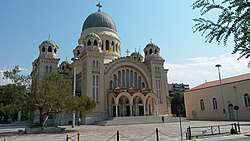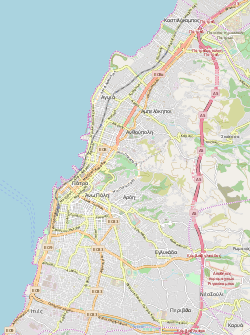Cathedral of Saint Andrew, Patras
The Cathedral of Saint Andrew or Cathedral Church of Saint Andrew (Greek: Ιερός Ναός Αγίου Ανδρέου) is a Greek Orthodox basilica in the west side of the city center of Patras in Greece. Along with the nearby old church of St. Andrew (Greek: Παλαιός Ιερός Ναός Αγίου Ανδρέου), it constitutes a place of pilgrimage for Christians from all over the world. It is dedicated to the First-called Apostle of Christ, Saint Andrew. Construction of the Greek Byzantine-style church began in 1908 under the supervision of the architect Anastasios Metaxas, followed by Georgios Nomikos. It was inaugurated 66 years later, in 1974[1]. According to University of Patras professor Ch. Apostolopoulos who has extensively studied the church building, the church has a surface area of 1,900 m2 on the ground floor and additionally 700 m2 on the first level (used as a gynaeconitis)[2]. The church has a length of ~60 m, width ~52 m and has a capacity of 7,000 people[2]. Other sources give similar numbers for the size of the surface area (there are different numbers depending on the inclusion or not of the first level)[3][4][5][6]. It is the largest church in Greece and the third largest Byzantine-style church in the Balkans, after the Cathedral of Saint Sava in Belgrade and Alexander Nevsky Cathedral in Sofia. Over the central dome there is a 5-meter-long, gold-plated cross and over the other domes, there are 12 smaller crosses[7]. These crosses symbolize Jesus and His apostles. The interior of the church is decorated with Byzantine-style wall paintings and mosaics.
| Cathedral of Saint Andrew Patras | |
|---|---|
Greek: Καθεδρικός Ναός Αγίου Ανδρέα | |
 | |
 Cathedral of Saint Andrew Patras | |
| 38°14′33″N 21°43′41″E | |
| Location | Patras |
| Country | Greece |
| Denomination | Greek Orthodox |
| History | |
| Status | Cathedral |
| Dedication | Andrew the Apostle |
| Architecture | |
| Functional status | Active |
| Architect(s) | Anastasios Metaxas Georgios Nomikos |
| Style | Byzantine architecture/Neo-Byzantine |
| Groundbreaking | 1908 |
| Completed | 1974 |
| Specifications | |
| Capacity | 1,900 m2 (area) 7,000 worshipers |
| Length | 59.8 metres (196 ft) |
| Width | 51.8 metres (170 ft) |
| Administration | |
| Metropolis | Patras |
Relics
.jpg)
Relics of the apostle Saint Andrew are stored in the church. They consist of the small finger, part of the top of the cranium of the Apostle, and small portions of the cross on which he was martyred, all kept in a special shrine. The holy skull of the Apostle was sent there from St. Peter's Basilica, Rome in September 1964, on the orders of Pope Paul VI. Cardinal Bea led the party of 15 cardinals that presented the relic to Bishop Constantine of Patras on 24 September 1964.[8] Thousands of people (among them prime minister Georgios Papandreou) and many Greek Orthodox bishops participated in the reception ceremony of the skull.[9][10] After a procession through the streets of the city, the skull was placed in a special silver miter inside the church. The cross of St. Andrew was taken from Greece during the Crusades by the Duke of Burgundy. Parts of the cross were kept since Middle Ages in the church of St. Victor in Marseilles. They were returned to Patras on 19 January 1980. The cross of the apostle was presented to the Bishop of Patras Nicodemus by the Roman Catholic delegation led by Cardinal Roger Etchegaray.[11][12]
Gallery
 The dome of Saint Andrew cathedral depicting Christ Pantocrator
The dome of Saint Andrew cathedral depicting Christ Pantocrator Interior
Interior Interior
Interior.jpg) Interior
Interior
 Interior view of the church. Beneath the dome hangs the central circular chandelier with depictions of the saints and apostles which in traditional Greek orthodox churches is called the horos.
Interior view of the church. Beneath the dome hangs the central circular chandelier with depictions of the saints and apostles which in traditional Greek orthodox churches is called the horos..jpg) Icon of Saint Andrew
Icon of Saint Andrew Mural depicting the meeting of Saint Apostole Andrew and Saint Peter with Jesus Christ. We read the inscription in Greek "Εὑρήκαμεν τὸν Μεσίαν" ("We have found the Messiah”, John 1:41)
Mural depicting the meeting of Saint Apostole Andrew and Saint Peter with Jesus Christ. We read the inscription in Greek "Εὑρήκαμεν τὸν Μεσίαν" ("We have found the Messiah”, John 1:41)
The old Temple
The older, much smaller, cathedral of St Andrew is located beside the current one. It was designed by Lysandros Kaftanzoglou in the late 19th century.
 View
View.jpg) Interior
Interior.jpg) Interior
Interior
See also
- Saint Andrew
- Apollon Theatre (Patras)
- Archaeological Museum of Patras
- Rio-Antirio bridge
- List of large Orthodox cathedrals
Sources
- Μ.Λεφαντζής, «Ο μεγάλος ναοδόμος Γεώργιος Νομικός», Περιοδικό Αρχιτέκτονες, Τεύχος 39, Μάιος-Ιούνιος 2003
- Χ. Αποστολόπουλος, «Ιστορικά Στοιχεία από την Ανέγερση-Βλάβες στη Δομή του Νέου Ναού του Αγίου Ανδρέα Πατρών», 3ο Εθνικό Συνέδριο, Ήπιες Επεμβάσεις για την Προστασία των Ιστορικών Κατασκευών, Νέες Τάσεις Σχεδιασμού, 9-11 Απριλίου 2009 Θεσσαλονίκη, σελ. 441-450.
- Κώστας Τριαντάφυλλου. «0 νέος μεγάλος ναός στην Πάτρα του Πολιούχου της Αγίου Ανδρέα», Πελοποννησιακή Πρωτοχρονιά (1962) 306-3
References
- Saint Andrew in History and Arts, International Conference, 17-19 November 2006,(pdf document in Greek)
- Dr. Ing. Ch. Apostolopoulos, Laboratory of technology and strength of Materials, University of Patras, Article with title "Historical data from construction - damages in the structure of the new church of Saint Andrew in Patras", 3rd National Conference Mild Interventions for the Protection of Historic Structures, Thessaloniki, 2009 (pdf article in Greek)
- Blog of Historian-Researcher Giannis Lyras
- Hellas Time - Church of Saint Andrew (In Greek)
- Discover Hellas - Largest church in Greece (in Greek)
- Saint Andrew Church information in the local website patrasinfo.com
- Video from a drone flying above the church (2015)
- Catholic Herald 2 October 1964 Archived 3 December 2013 at the Wayback Machine
- Reception of the precious skull of St. Andrew (in Greek)
- Video of the reception ceremony from the Hellenic National AudioVisual Archive site
- Historical note on the reception of the cross of St. Andrew (in Greek) Archived 17 February 2013 at Archive.today
- Abbaye Saint-Victor de Marseille, monuments historiques en France (in French)
External links
| Wikimedia Commons has media related to Cathedral Agios Andreas. |